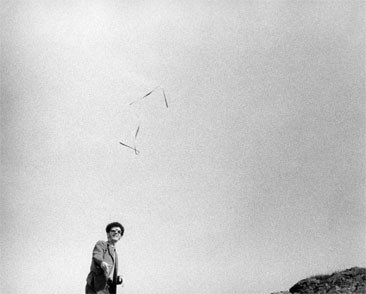
Born in 1937 in Cincinnatti, Ohio (US). Lives and works in San Francisco (US).

1969
b&w photograph
79 x 98 cm (avec cadre)
Year of Purchase: 2007
“One Second Sculpture, 1969. Action. San Francisco. Instrument made from a metal tape measure that flies like a spring in one second. The object leaves the hand as a circle, makes a drawing in space and falls to the ground as a line.” At least, it’s clear. Who said that contemporary art should be complicated? The only proof and testimony to that exceedingly simple, yet dazzling performance, is a photo taken at the exact moment when the tape measure uncoils in the air. Not before, not after. Is this art? Yes. In so far as it is a transformation in the form of a material (metal). Yes, in so far as it traces a line in the blue of the sky. Yes, in so far as it is a form given to an idea: the suspension of time, lightness, chance. Moreover, it is a total work of art: sculpture, drawing, performance, photography… and even music: the dry snapping of the metal as a cymbal. A one second symphony. It’s art and it is a spectacle: prestidigitation on a modest scale, without means, a snail that transforms into a dove that transforms into a serpent. And, voilà, the hands are empty, as are the pockets. Magic. Of course, there’s a trick. Sculpture, which is a matter of space and volume, subtly integrates time. Which is, as we well know, another grand condition of existence. Time, movement, urgency. Life in a nutshell. Low-tech kinetic art. Life—hence, inevitably, death. A second and then nothing. Click-clack Kodak, wind up, and it’s done. It’s short (in comparison, John Cage’s “4 minutes 33” of silence is an eternity…) One could not imagine more ephemeral, fleeting, anti-conservation art. It is impossible to pin it down. Has it made it? Even that is not certain. Tom Marioni is fascinated by Zen philosophy as an exercise in simplicity and brevity, in suspension. Here, it’s a dollar-store version. In his Empire of Signs¸ Roland Barthes states that Satori is precision and void, assurance and independence of the gesture. I am also giving a skimmed down version, but the idea is clear: the dazzling absolute, where the outline and the regret, “maneuver and revision” are forbidden. Visual haiku: Throw / unfold / fall. This pretty much sums up life. Think about it. Visual haiku? Haiku, period (sorry, pleonasm). One / Second / Sculpture. But above all, a gesture. Immediate, radical, determined. A first draft, in a sense. Ah Ah Ah. Stop, the shortest performances are the best. A ludicrous, demonstrative and subtly paradoxical gesture: a tape measuring time rather than space. A chaotic unfolding which will always end the same way. The shepherdess’s response to Mallarmé: a throw of the tape will always abolish chance. It will end up stiff, as we all do. The last “straight” line, in a way. An homage to sculpture, but also to photography. Without it, everything would literally have never been captured. To reveal the physical invisible. Remember Muybridge, Marey, the galloping horse. The suspension in the air, already there. So, quickly, Henri Bergson, fluid and infinite time, absolutely indivisible, impossible to perceive outside “intuition”, etc. But also, élan vital. Matter and memory. But we’re dragging, dragging. Another thing. Tom Marioni became known in the 1970s with his famous “The Act of Drinking Beer with Friends is the Highest Form of Art”, a series of collective performances based on alcoholic conviviality. How does it relate to One Second Sculpture, another historical work? Release of pressure (in all senses of the term). Relaxation. Suspended time. Jubilation, elevation. Quick, quick, one last thing. You know the popular, vertiginous and unverifiable image: the world, the earth, as born from the gesture of someone carelessly throwing some dust into the air? And that dust twirls before hitting the ground, the whole earth, the entire world, humanity, us, etc. In a split second, the whole world. Well, it’s like this with Tom and the history of art. Time, space, art, thought, gesture, etc. Yes yes, there’s all that, in that simple throw of a tape measure. You’re not sure? Think about it. History is not composed of objects but of events.
Guillaume Desanges